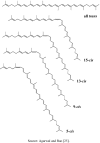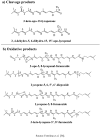Revealing the power of the natural red pigment lycopene
- PMID: 20335956
- PMCID: PMC6263198
- DOI: 10.3390/molecules15020959
Revealing the power of the natural red pigment lycopene
Abstract
By-products derived from food processing are attractive source for their valuable bioactive components and color pigments. These by-products are useful for development as functional foods, nutraceuticals, food ingredients, additives, and also as cosmetic products. Lycopene is a bioactive red colored pigment naturally occurring in plants. Industrial by-products obtained from the plants are the good sources of lycopene. Interest in lycopene is increasing due to increasing evidence proving its preventive properties toward numerous diseases. In vitro, in vivo and ex vivo studies have demonstrated that lycopene-rich foods are inversely associated to diseases such as cancers, cardiovascular diseases, diabetes, and others. This paper also reviews the properties, absorption, transportation, and distribution of lycopene and its by-products in human body. The mechanism of action and interaction of lycopene with other bioactive compounds are also discussed, because these are the crucial features for beneficial role of lycopene. However, information on the effect of food processing on lycopene stability and availability was discussed for better understanding of its characteristics.
Figures
Similar articles
-
Lycopene in tomatoes: chemical and physical properties affected by food processing.Crit Rev Food Sci Nutr. 2000 Jan;40(1):1-42. doi: 10.1080/10408690091189275. Crit Rev Food Sci Nutr. 2000. PMID: 10674200 Review.
-
Lycopene in tomatoes: chemical and physical properties affected by food processing.Crit Rev Biotechnol. 2000;20(4):293-334. doi: 10.1080/07388550091144212. Crit Rev Biotechnol. 2000. PMID: 11192026 Review.
-
Carotenoid composition and antioxidant activities of Chinese orange-colored tomato cultivars and the effects of thermal processing on the bioactive components.J Food Sci. 2021 May;86(5):1751-1765. doi: 10.1111/1750-3841.15682. Epub 2021 Apr 15. J Food Sci. 2021. PMID: 33856048
-
Natural Origin Lycopene and Its "Green" Downstream Processing.Crit Rev Food Sci Nutr. 2016;56(4):686-709. doi: 10.1080/10408398.2013.817381. Crit Rev Food Sci Nutr. 2016. PMID: 25671774 Review.
-
Tunisian tomato by-products, as a potential source of natural bioactive compounds.Nat Prod Res. 2017 Mar;31(6):626-631. doi: 10.1080/14786419.2016.1209671. Epub 2016 Aug 10. Nat Prod Res. 2017. PMID: 27686856
Cited by
-
Effects of Incorporating Caramel, Carrot, and Tomato Powder on the Quality Characteristics of Soy Protein-Based Meat Patties.Foods. 2024 Jul 15;13(14):2224. doi: 10.3390/foods13142224. Foods. 2024. PMID: 39063308 Free PMC article.
-
Antioxidant, anticancer activity and molecular docking study of lycopene with different ratios of Z-isomers.Curr Res Food Sci. 2023 Feb 4;6:100455. doi: 10.1016/j.crfs.2023.100455. eCollection 2023. Curr Res Food Sci. 2023. PMID: 36815997 Free PMC article.
-
Scientific Evidence of the Beneficial Effects of Tomato Products on Cardiovascular Disease and Platelet Aggregation.Front Nutr. 2022 Mar 15;9:849841. doi: 10.3389/fnut.2022.849841. eCollection 2022. Front Nutr. 2022. PMID: 35369095 Free PMC article. Review.
-
Natural Products in Mitigation of Bisphenol A Toxicity: Future Therapeutic Use.Molecules. 2022 Aug 24;27(17):5384. doi: 10.3390/molecules27175384. Molecules. 2022. PMID: 36080155 Free PMC article. Review.
-
Use of Time-Resolved Fluorescence to Monitor Bioactive Compounds in Plant Based Foodstuffs.Biosensors (Basel). 2015 Jun 26;5(3):367-97. doi: 10.3390/bios5030367. Biosensors (Basel). 2015. PMID: 26132136 Free PMC article. Review.
References
-
- Mortensen A. Carotenoids and other pigments as natural colorants. Pure Appl. Chem. 2006;78:1477–1491. doi: 10.1351/pac200678081477. - DOI
-
- Rodriguez-Amaya D.B., Kimura M. Harvestplus Handbook for Carotenoid Analysis. IFPRI and CIAT; Washington, DC, USA: 2004. Carotenoids in foods; pp. 2–7.
-
- Rodriguez-Amaya D.B. A Guide to Carotenoid Analysis in Foods. ILSI Press; Washington, D.C., USA: 2001. pp. 1–45.
-
- Focus on Pigments. World spends more than $50 M on lycopene red. Focus Pigm. 2007;4:3–4.
Publication types
MeSH terms
Substances
LinkOut - more resources
Full Text Sources




